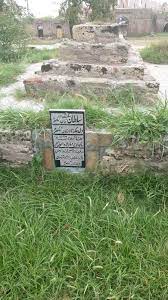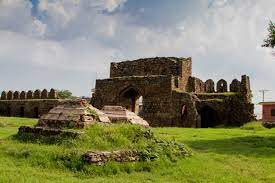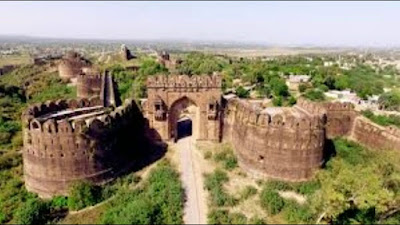Historical Overview of Fort Rawat
Rawat Shahi Fort is located 17 km east of Rawalpindi and was built in the early 16th century. This fort has a centuries-old history. It is reminiscent of a battle fought between Sultan Sarang Khan, chief of the Gakhar, and Sher Shah Suri at this place in 1546.
There are many traditions about the construction of the fort but everyone agrees that it was earlier a caravan inn where various caravans used to camp.
The rooms inside suggest that there was an overnight stay for travelers. Some experts believe that the caravan inn was built during the reign of Mahmud Ghaznavi and some, considering its architectural style, speculate that it was built during the reign of the Delhi Sultans. Rawat Shahi Fort, also known as Rawat Fort, is not mentioned explicitly in Tuzk e Babri.

But according to historians, the Mughal king Humayun was militarily assisted in exile by the Gakhar tribes of Pothohar, in return for which the Gakhar tribes suffered heavy losses at the hands of Sher Shah Suri, an opponent of the Mughals.
Mughal Emperor and Rawat Fort
In his second reign, the Mughal emperor Humayun rewarded his loyal friends. Paranga Rawat, Paranga Pharwala and Paranga Dhangli are mentioned in Humayun Nama.
When Jalaluddin Muhammad Akbar became king after Humayun, there were first twelve provinces and then 15 provinces.
The management of the provinces was the responsibility of the officials. In the affairs of the kingdom, the government came under the province. There were various 'Parangas' in today's district or tehsil.

The criminal system was divided into three parts. The man from different villages who were given the Paranga had to recruit the cavalry.
Fort Rawat A Paranga
Fort Rawat was also a Paranga for which different villages were given. The king did not recruit any army directly. Maharaja Man Singh, the general of Jalaluddin Muhammad Akbar, the spirit of the military division of Pothohar, corrected the Mughal army system by giving wealth to the Gakhar, Rajput, and other warring tribes. He gave up the estates and organized the army.
Construction of Rohtas Fort
In those days many of Humayun's friends took refuge in the court of Sher Shah Suri. After defeating Humayun here, Sher Shah's eyes were on the area of Gakhar. He decided to build a fort on a high mound at Rohtas.

One of the purposes of building this fort was to keep a close eye on the Gakhar's area. Sultan Sarang was not unaware of the movement of Sher Shah Suri's army.
Preparations were underway in the fort of Rawat to defend this land. This fort of Rawat is smaller than ordinary forts and was built in a square shape.
Sultan Sarang Khan Chief Gakhar Tribe
On the walls of the fort, the commanders were watching the movement of the enemy army. The distance between Rawat fort and Rohtas fort will be about fifty miles but Sultan Sarang Khan, the chief of Pothohar Gakhar tribe was made of some other clay.
He was the chief of Gakhars in and around Rawat and in the history of Punjabi tribes, Gakhars are mentioned as a brave and courageous tribe.
Sultan Sarang Khan A Brave Chief
When Sultan Sarang Khan consulted the people of his tribe, they all agreed and said that we were with the Mughals and would stay with the Mughals. It was a difficult decision. Sher Shah Suri's army had defeated the Mughal army.
And the Gakhar's army was much smaller than Sher Shah's army. But Sultan Sarang Khan decided to fight Sher Shah Suri instead of expediently and then one day the dust flying from afar informed that the enemy army was coming.
Sultan Sarang's valiant soldiers bravely confronted Sher Shah's army. Sultan Sarang was writing a history of bravery with his sons. Sixteen of his sons were sacrificed one by one on their own soil.
Eventually, Sultan Sarang was captured wounded by Sher Shah's army, and tortured. While alive, his skin was pulled out and separated from his body.
Loyality of Sarang Khan
Thus Sarang Khan was punished for keeping his promise to the Mughals Even now, if you pass through Rawat and go to Rawat Fort, you will find some graves along with dilapidated buildings.

One of these graves is that of Sultan Sarang, Who is sleeping with his sixteen sons in the land of this fortress.
Facts, Rawat Fort
Qila Rawat is located on a mountain range that extends eastward from Kahuta. It stretches from Khushalgarh in the south of Rawalpindi to the Indus River.
Mosque and Dome
The fort is almost square in shape and has two large gates. The fort also has a mosque with three large rooms in the shape of a dome. And they are in relatively good condition. There is a square building with a dome.

There are many small rooms along its wall. Which are important in terms of defense. There are many tombs in the center of the fort, one of which belongs to Sultan Sarang Khan.
Graves of his 16 Sons
There are also graves of his 16 sons who were killed while fighting here. After the formation of Pakistan, the fort was given under the supervision of the endowment department and was renamed Shahi Qila.
Protection Wall
There is also a mosque in it which is still inhabited and reminiscent of ancient times. There is a strong wall around the fort that protects it from the evils of external enemies.
Dilapidated Condition
In addition to this, its walls were also damaged by the people of Rawat who started tearing down its walls to build houses. However, the government has banned construction along the walls and created beautiful gardens on both sides of the fort.
Meaning of Rawat
According to the inscription on the iron board outside the main gate of the fort, the Arabic word 'Rawat' is the form of the word 'Rabat', which literally means 'inn'.
This suggests that the present fort was in fact an ancient caravan inn. Which was built along the General Road for the convenience of passengers or for the accommodation of government officials.

Architecture and History of Rawat Fort
Its architecture suggests that the fort-like inn was built in the early fifteenth century during the reign of the Delhi Sultans.
But this fort is attributed to Masood, the son of Sultan Mahmud of Ghazni, which dates back to 1036. And it is said that the rebel soldiers of his army captured him in this fort and later took him to Gaddi fort near Taxila and killed him.
The fort later came under the control of Sarang Khan, chief of the Gakhar tribe. The present fort consists of a wall and a gate.
The main door faces east, while the back door opens to the north. Inside the wall are chambers on all sides, and other historic buildings include an octagonal mausoleum, a mosque, and a few tombs.
The ancient royal mosque on the grounds of Qila Rawat tells the story of the rise of Muslims in the region for centuries.
Important in terms of Defence
Due to its high altitude, the fort is also very important in terms of defense. From here, effective control over Islamabad, Rawalpindi, and the surrounding area can be achieved.
Needs Government Attention
Domestic and foreign tourists keep coming here and if the government pays a little attention, it can be made an encouraging place for tourism.
However, the government needs to pay attention to this historic site so that it can be passed on to future generations.
